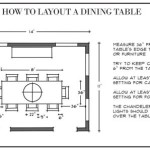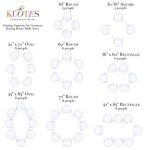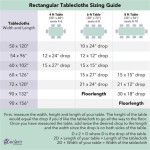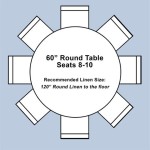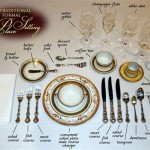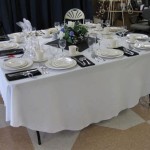A Comprehensive Guide To Table Round Tops Of Tables
The round table top, a staple in both residential and commercial spaces, offers a unique blend of functionality and aesthetic appeal. Its circular form promotes conversation and inclusivity, making it a popular choice for dining areas, meeting rooms, and social gatherings. Understanding the various materials, sizes, and design considerations associated with round table tops is crucial for selecting the ideal option for a specific application.
This comprehensive guide explores the different aspects of round table tops, providing in-depth information regarding material selection, size considerations, edge profiles, base compatibility, and maintenance procedures. The aim is to equip readers with the knowledge necessary to make informed decisions when choosing a round table top that meets their specific needs and complements their overall décor.
Material Options for Round Table Tops
The material selection for a round table top significantly impacts its durability, aesthetics, and cost. A wide range of materials are available, each possessing unique characteristics that make it suitable for different applications.
Wood: Wood remains a popular choice due to its natural beauty, warmth, and versatility. Hardwoods such as oak, maple, and walnut offer excellent durability and scratch resistance, while softer woods like pine and fir can be more susceptible to damage. Wooden table tops can be finished with various stains, paints, or varnishes to achieve a desired look and level of protection. Solid wood tops require careful attention to humidity levels to prevent warping or cracking.
Laminate: Laminate table tops consist of a decorative layer adhered to a substrate, typically particleboard or MDF. They offer a cost-effective alternative to solid wood and are available in a vast array of colors, patterns, and textures, including realistic wood-grain and stone-like finishes. Laminate surfaces are relatively durable, easy to clean, and resistant to stains and scratches, making them a practical choice for high-traffic areas.
Metal: Metal table tops, often constructed from stainless steel, aluminum, or wrought iron, offer a modern and industrial aesthetic. Stainless steel is particularly popular for its durability, corrosion resistance, and hygienic properties, making it suitable for food service environments. Metal table tops can be powder-coated or painted to achieve different colors and finishes. Consider the potential for dents and scratches, especially with softer metals like aluminum.
Glass: Glass table tops provide a sleek and contemporary look, allowing light to pass through and creating a sense of openness. Tempered glass is recommended for safety reasons, as it is much stronger than standard glass and shatters into small, relatively harmless pieces if broken. Glass table tops are easy to clean but can be prone to scratches and fingerprints. The thickness of the glass is important for structural integrity, particularly for larger diameters.
Stone: Stone table tops, such as granite, marble, and quartz, offer a luxurious and durable option. Granite is known for its exceptional hardness and resistance to heat and scratches, while marble provides a classic and elegant aesthetic. Quartz is an engineered stone that combines natural quartz with resins, offering a wider range of colors and patterns than natural stone. Stone table tops are heavy and require a sturdy base for support. They can also be porous, so proper sealing is necessary to prevent staining.
Resin: Resin table tops, often made from epoxy resin, allow for unique and artistic designs. Resin can be combined with various materials, such as wood, metal, and pigments, to create custom patterns and colors. Resin surfaces are typically durable, waterproof, and resistant to scratches, making them a popular choice for both residential and commercial applications.
Size and Dimension Considerations for Round Table Tops
Selecting the appropriate size for a round table top is crucial for ensuring comfortable seating and optimal functionality. The ideal diameter depends on the intended use of the table and the number of people it needs to accommodate.
Seating Capacity: A general guideline for determining the appropriate diameter of a round table top based on seating capacity is as follows: a 36-inch diameter table can comfortably seat 2-4 people, a 48-inch diameter table can accommodate 4-6 people, a 60-inch diameter table can seat 6-8 people, and a 72-inch diameter table can seat 8-10 people. These are just guidelines, and individual preferences may vary. Consider allowing at least 24 inches of space per person for comfortable seating.
Room Size: The size of the room in which the table will be placed is also a significant factor. Ensure that there is enough space around the table for comfortable movement and that the table does not overwhelm the room. A minimum of 36 inches of space between the table and the surrounding walls or furniture is generally recommended.
Purpose of the Table: The intended use of the table will also influence the ideal size. A small round table may be suitable for a cafe or bistro setting, while a larger round table is necessary for a dining room or conference room. Consider the types of activities that will take place at the table and the amount of surface area required.
Base Compatibility: The size and design of the table base must be compatible with the round table top. The base should be sturdy enough to support the weight of the table top and provide adequate stability. The diameter of the base should be proportionate to the diameter of the table top to prevent tipping. Central pedestal bases are a common choice for round tables, as they provide ample legroom and stability.
Accessibility Considerations: For accessible seating, ensure that there is adequate knee clearance under the table. The Americans with Disabilities Act (ADA) provides guidelines for accessible table heights and knee clearance. Round tables can be more accessible than rectangular tables, as they allow for easier maneuvering of wheelchairs.
Edge Profiles and Design Details
The edge profile of a round table top contributes significantly to its aesthetic appeal and functionality. Different edge profiles offer varying degrees of comfort, durability, and visual interest.
Square Edge: A square edge provides a clean and modern look. It is often used for contemporary designs and offers a crisp and defined silhouette. Square edges can be sharp, so careful attention should be paid to finishing and sanding to prevent splinters or injury.
Rounded Edge: A rounded edge provides a softer and more comfortable feel. It is a popular choice for dining tables and children's furniture, as it reduces the risk of injury from sharp corners. Rounded edges can be achieved through various methods, such as routing or sanding.
Beveled Edge: A beveled edge is angled, creating a decorative detail that adds visual interest. Beveled edges can be subtle or dramatic, depending on the angle and width of the bevel. They are often used for more formal or traditional designs.
Ogee Edge: An ogee edge features a concave curve that transitions into a convex curve. It is a classic and elegant edge profile that is often used for high-end furniture. Ogee edges require specialized tooling and craftsmanship.
Bullnose Edge: A bullnose edge is fully rounded, creating a soft and smooth profile. It is a durable and comfortable edge profile that is often used for countertops and tables. Bullnose edges are easy to clean and maintain.
Live Edge: A live edge preserves the natural edge of the wood, showcasing the unique character and grain patterns of the tree. Live edge table tops are often used for rustic or natural designs. They require careful preparation and finishing to ensure longevity and stability.
In addition to edge profiles, other design details can enhance the appearance of a round table top. These include decorative inlays, contrasting edge banding, and custom finishes. Consideration should be given to how these details complement the overall style and décor of the room.
Choosing the right round table top involves careful consideration of material, size, and design details. By understanding the various options available and taking into account specific needs and preferences, individuals can select a round table top that provides both functionality and aesthetic appeal for years to come.

Choosing The Right Dining Table Size Your Ultimate Guide Cabinfield Blog

How To Build A 70 Round Dining Table Honey Built Home

Modern Coastal Round Dining Tables Life On Virginia Street

Edge Profiles For Solid Wood Table Tops

Ultimate Guide To Round Table How Choose The Perfect Size

How Do I Measure My Table To Order A Glass Top
Round Dining Tables Furniture Village

The Ultimate Guide To Dining Tables In Singapore

Guide To Tables

Best Round Dining Table For 6 Dutch Craft Furniture
Related Posts

